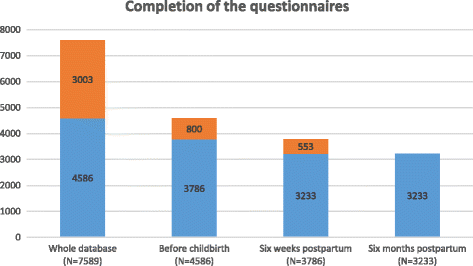Sociodemographic and delivery risk factors for developing postpartum depression in a sample of 3233 mothers from the Czech ELSPAC study
- PMID: 28327118
- PMCID: PMC5361789
- DOI: 10.1186/s12888-017-1261-y
Sociodemographic and delivery risk factors for developing postpartum depression in a sample of 3233 mothers from the Czech ELSPAC study
Abstract
Background: In the postpartum period, certain groups of women are at a higher risk for developing depressive episodes. Several studies have described risk factors for developing postpartum depression (PPD). However, these studies have used limited numbers of participants, and therefore the estimated prevalence of PPD varies greatly.
Methods: The objective of this study is to identify the main risk factors for developing PPD by using data collected via the Czech version of the European Longitudinal Study of Pregnancy and Childhood (ELSPAC). This database provides a representative sample (n = 7589) observed prospectively and a large amount of data on depressive symptoms and on biological, socioeconomic, and environmental factors. The Edinburgh Postnatal Depression Scale (EPDS) was used to screen for incidence of PPD. The affective pathology was examined at three time points: before delivery, 6 weeks after delivery, and 6 months after delivery.
Results: The prevalence of depressive symptoms before delivery was 12.8%, 6 weeks after delivery 11.8%, and 6 months after delivery 10.1%. The prevalence rates are based on women who completed questionnaires at all three time-points (N = 3233). At all three time points, the main risk factors for developing PPD identified as significant by both univariate and multivariate analysis were personal history of depressive episodes and mothers experiencing psychosocial stressors. Other risk factors occurring in both types of analysis were: family history of depression from expectant mother's paternal side (prenatal), mothers living without partners (6 weeks postpartum) and feelings of unhappiness about being pregnant (6 months postpartum). Several protective factors were also observed: male child gender (prenatal), primiparous mothers (6 months postpartum), and secondary education (prenatal, only by multivariate analysis). Significant risk factors found solely by univariate analysis were family history of depression in both parents of the expectant mother (prenatal and 6 weeks postpartum), family history of depression from subject's maternal side (6 months postpartum), unintentional pregnancy (prenatal and 6 weeks postpartum), feelings of unhappiness about being pregnant (prenatal and 6 weeks postpartum), primary education (prenatal and 6 weeks postpartum), mothers who opted not to breastfeed (6 months postpartum) and mothers living without partners (prenatal and 6 months postpartum). Family savings were identified as protective factor (prenatal and 6 months postpartum).
Conclusions: We identified significant predictors of PPD. These predictors can be easily detected in clinical practice, and systematic screening can lead to identifying potentially at risk mothers. Since the risk is linked with experience of psychosocial stressors it seems that they might benefit from increased psychosocial support to prevent affective pathology.
Keywords: ELSPAC; EPDS; Mood disorders; PPD; Postpartum blues; Postpartum depression; Risk factors.
Figures
Similar articles
-
[Screening and intervention for depressive mothers of new-born infants].Seishin Shinkeigaku Zasshi. 2003;105(9):1129-35. Seishin Shinkeigaku Zasshi. 2003. PMID: 14639935 Japanese.
-
Predictive validity of the Postpartum Depression Predictors Inventory-Revised (PDPI-R): A longitudinal study with Portuguese women.Midwifery. 2019 Feb;69:113-120. doi: 10.1016/j.midw.2018.11.006. Epub 2018 Nov 17. Midwifery. 2019. PMID: 30496938
-
The effects of intrapartum synthetic oxytocin on maternal postpartum mood: findings from a prospective observational study.Arch Womens Ment Health. 2019 Aug;22(4):485-491. doi: 10.1007/s00737-018-0913-3. Epub 2018 Oct 10. Arch Womens Ment Health. 2019. PMID: 30306269 Free PMC article.
-
Anxious and depressive components of Edinburgh Postnatal Depression Scale in maternal postpartum psychological problems.J Perinat Med. 2013 Jul;41(4):343-8. doi: 10.1515/jpm-2012-0258. J Perinat Med. 2013. PMID: 23426862 Review.
-
New parents' experiences of postpartum depression: a systematic review of qualitative evidence.JBI Database System Rev Implement Rep. 2019 Sep;17(9):1731-1769. doi: 10.11124/JBISRIR-2017-003909. JBI Database System Rev Implement Rep. 2019. PMID: 31021977
Cited by
-
Gender discrimination and depressive symptoms among child-bearing women: ELSPAC-CZ cohort study.EClinicalMedicine. 2020 Mar 4;20:100297. doi: 10.1016/j.eclinm.2020.100297. eCollection 2020 Mar. EClinicalMedicine. 2020. PMID: 32300743 Free PMC article.
-
Factor Structure of the Edinburgh Postnatal Depression Scale in a Sample of Postpartum Slovak Women.Int J Environ Res Public Health. 2021 Jun 10;18(12):6298. doi: 10.3390/ijerph18126298. Int J Environ Res Public Health. 2021. PMID: 34200855 Free PMC article.
-
Is physical activity in pregnancy associated with prenatal and postnatal depressive symptoms?: Results from MAASTHI cohort study in South India.J Psychosom Res. 2021 May;144:110390. doi: 10.1016/j.jpsychores.2021.110390. Epub 2021 Feb 10. J Psychosom Res. 2021. PMID: 33740554 Free PMC article.
-
Prevalence and predictors of postpartum depression and generalized anxiety symptoms among women who delivered at a tertiary hospital in Mwanza Tanzania: a cross-sectional study.Discov Ment Health. 2024 Jun 8;4(1):21. doi: 10.1007/s44192-024-00074-5. Discov Ment Health. 2024. PMID: 38849688 Free PMC article.
-
Assessing the Risk of Depression Tendency in Pregnancy and Puerperium during COVID-19 Pandemic in Poland.Healthcare (Basel). 2023 Jul 12;11(14):2005. doi: 10.3390/healthcare11142005. Healthcare (Basel). 2023. PMID: 37510446 Free PMC article.
References
-
- Kennedy R, Suttenfield K. Postpartum Depression. Medscape Psychiatry Ment Heal eJournal. 2001. http://www.medscape.com/viewarticle/408688. Accessed 25 June 2015.
-
- Association AP. The Diagnostic and Statistical Manual of Mental Disorders. Fifth ed: DSM 5. Washington, D.C: American Psychiatric Association; 2013.
MeSH terms
LinkOut - more resources
Full Text Sources
Other Literature Sources
Medical


